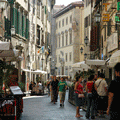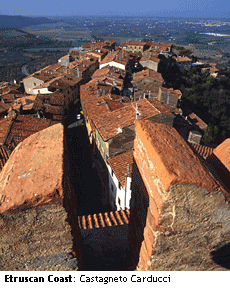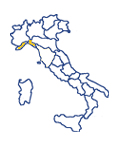

Reserve Livorno Hotels: save up 70% on rooms!
Compare offers & book on line at hotel's web sites. |
|

|
|
Livorno & Etruscan Coast Guide Italy
The Etruscan Coast
|
|
|
|
|
The Etruscan Coast
This itinerary leads to the discovery of the coastal area which extends south until Piombino, crossing what was once the enormous feud of the Della Gherardesca counts. This is the "Etruscan Coast" wine road. This is the homeland of precious gems of modern enology, like Sassicaia and Ornellaia, two of the most praiseworthy Cabernets in the entire world. The road winds around a very charming hilly area, passing through woods on one side and the sea on the other, dotted with age-old peasant villages which the hordes of tourists have not touched.
The itinerary is best covered in two or three days, but you can stop longer to relax on one of the many beaches or take to the Tuscan scrub for long hikes, bike rides or horseback riding. You can choose from a selection of hotels on the Etruscan Coast for a stay characterized by relaxation. For those who prefer a different type of accommodation, there is a vast selection of cozy bed-and-breakfasts on the Etruscan Coast or one of the numerous country guesthouses on the Etruscan Coast, scattered in the gentle landscapes of this countryside.
Bolgheri
This town situated in a fertile countryside among vineyards and olive groves is famous throughout the world for its great wines (Sassicaia, Ornellaia etc) and for its long road of cypresses which the poet Carducci immortalized in his famous "Davanti a San Guido".
The village is entered through a 16th century castle in red brick. The historical center has maintained its old ring shaped structure where the paved alleys, stone houses and old artisan factories and workshops surround the visitor in an atmosphere of past times.
Castagneto Carducci
Another enchanting medieval village built around the Gherardesca Castle, starting in the year 1000. Wander around the paved roads of the town, which lead to pretty squares and terraces overlooking the sea and countryside. A visit to the former Courthouse, now home to the municipal government and Church of San Lorenzo is interesting. Each spring Castagneto is the venue for a major gourmet festival which attracts enthusiasts from all over Italy.
Suvereto
This is the prettiest medieval village of the Etruscan Coast, filled with history and art, situated in a green valley among typical woods of cork oaks, oaks and chestnut trees. The town has preserved its historical appearance: The old walls contain a myriad of buildings, churches, paved roads and the medieval workshops in stone.
Things to see: outside the walls, near the main gate, is the church of San Giusto, dating back to the 12th century. The Romanesque portal with Byzantine decorations stands out on the facade; the interior with typical Romanesque forms bathed in a dim light is charming. Rocca Aldobrandesca, dating back to before 1000, just like the walls and towers which surround the village, sits at the top of the hill. One of the prettiest buildings of the village is the Palazzo Comunale dating back to the 13th century. The entrance is interesting. It is known as the Loggiato dei Giudici, because it was from here that the local judges read their verdicts in the Middle Ages. The former San Francesco Monastery is located in the opposite part of the city. It was built starting in 1286 and suppressed by Napoleon at the beginning of the 19th century. The fascinating cloister of the convent, which has remained intact, is not to be missed.
The Suvereto Festival is held every year in December: exhibitions, culture, folklore and gourmet specialties revolving around wild boar.
Campiglia
A medieval village enclosed by walls, where the alleys and street are laid out in concentric semi-circles around a castle. Artisan workshops, museums, shops and restaurants line its squares.
Things to see: Palazzo Pretorio, the seat of political power, its current appearance is the result of various architectural transformations. The facade contains 72 coats of arms which bear witness to the passage of captains who rose to power. The building houses an archeological museum (with artefacts from the old fortress) and an interesting Public Wine Shop. The Wine Shop is open every day by reservation: Tel/Fax +39.0565.837201.
Other things worth seeing: the church of San Lorenzo, built in the 13th century, but modified over time, and church of San Giovanni, which stands outside the walls, and is beautiful with its pure Tuscan Romanesque simplicity.
San Silvestro Archeomining Park
Located a short distance from Campiglia, it is an extraordinary outdoor museum which preserves unique remains of the mining and metal working activity from the Etruscan period to present. You will visit the remains of the medieval mining village of San Silvestro, the old underground mine and the Park Museum and you can enjoy thrilling archeological/mining hikes to discover the Park.
Venturina hot springs
In Venturina, a short distance from Campiglia, there is a hot spring which supplies the "Il Calidario" spa. The water gushes out at a temperature of 36 °C in a pretty thermal spa, known as early as Etruscan times. The thermal lake is open almost all year, from morning until night.
Populonia
Populonia was one of the most powerful Etruscan cities, the most important center for working and trading iron. The city was divided into an upper part (acropolis) and an "industrial" part on the coast where the port and iron furnaces were located. Populonia declined with the rise of Rome, so much so that in the 1st century AD it had already been abandoned. The city now sits at the top of a hill surrounded by the sea. It has a medieval appearance with defensive walls and a massive 15th century fortress.
Archeological Park of Baratti and Populonia
Located in a setting of rare beauty, the Park offers an extraordinary view of the history of this great Etruscan city. You'll visit the remains of the buildings used for refining minerals in the old industrial quarter. Next you'll discover the ancient necropolises, with superb examples of monumental tombs. Lastly, there is a nature route which crosses the woods leading to the Grotte necropolis, ancient Etruscan caves of the Hellenistic period (4th-3rd century BC) which were converted into a burial area. Archeology enthusiasts can learn more about the history of this area in the Archeological Museum in Piombino set up inside the fortress. Prehistoric, Etruscan and Roman artefacts from Populonia are displayed as well as scale models of prehistoric and Etruscan furnaces and tombs.
Go to directories of the Web Sites
Photos courtesy of: APT Costa degli Etruschi and Comune di Livorno
|
|
|
|
|
Acquista la tua visibilità su Travel Plan
|
|
|
|





